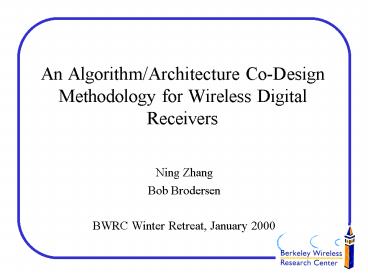An AlgorithmArchitecture CoDesign Methodology for Wireless Digital Receivers - PowerPoint PPT Presentation
1 / 14
Title:
An AlgorithmArchitecture CoDesign Methodology for Wireless Digital Receivers
Description:
Netlist and Floor Plan of. Macro Modules Standard Cells. Back-end Design flow ... with PDA Models. Data Flow (construct with parameterized modules) ... – PowerPoint PPT presentation
Number of Views:55
Avg rating:3.0/5.0
Title: An AlgorithmArchitecture CoDesign Methodology for Wireless Digital Receivers
1
An Algorithm/Architecture Co-Design Methodology
for Wireless Digital Receivers
- Ning Zhang
- Bob Brodersen
- BWRC Winter Retreat, January 2000
2
Wireless Communication System Trend
- Increasing demands
- High capacity
- High data rate
- with constraints
- Portability
- low energy consumption
- small form factor
- Fast time-to-market
3
The Gap Between Reality and Theory
Commercial Systems (Proxim WLAN)
New Theoretical Results (Lucent V-BLAST)
Spectral Efficiency
Single-user 1-2 bps/Hz Multi-user 0.3 bps/Hz
12-40 bps/Hz
Implementation
1/10 of real-time, 650 Kbps 4 TMS32C40 DSP 7 W
1.6 Mbps 750 mW(includes analog)
Lower Power High Performance at high data rate
4
Problem Statement
- How to facilitate low power digital
implementation of high performance wireless
communication algorithms?
Algorithm
Establish an algorithm/architecture co-design
methodology that enables efficient and effective
algorithm and architecture explorations.
Architecture
Digital Signal Processor
Dedicated Hardware
Reconfigurable Hardware
5
Methodology Outline
Algorithm
Algorithm Characteristic Evaluation
Architecture
Digital Signal Processor
Dedicated Hardware
Reconfigurable Hardware
6
Algorithm Evaluation
Performance and Implementation Complexity
- Theoretical capacity
- Algorithm performance
- e.g., convergence speed of adaptive algorithm
- Operation count
- Operation breakdown
- e.g., MULT, DIV, SQRT, ALU and MEM
- Sensitivity to analog circuit nonidealities
- Numerical robustness with finite precision
- Structure
- e.g., locality, regularity and concurrency
Performance
Implementation Complexity
7
Methodology Outline
Algorithm
Architectural Implementation Estimation
Architecture
Digital Signal Processor
Dedicated Hardware
Reconfigurable Hardware
8
Architectural Implementation Estimation
- Digital Signal Processor
- Kernel benchmark approach
- Start from existing architectures
- compiled assembly codes instruction level power
characterizations - Evaluate relative improvements for extensions of
architectures - Retargetable estimation Ghazal
- Reconfigurable Hardware
- Pleiades Wan
- Stream-based dataflow architecture Kienhuis
- Dedicated Hardware
9
Low Power Design Techniques
- Identify and Estimate Potential Improvements
- Accumulate Design Knowledge
- Algorithm
- Reduce operation complexity
- Optimize computation structure
- Architecture
- Optimize fundamental components
- Reduce overhead components
10
Methodology Outline
Algorithm
Fast and Predictable Implementation Path
Architecture
Digital Signal Processor
Dedicated Hardware
Reconfigurable Hardware
11
Front-End Design for Dedicated Hardware
Fast and Predictable Implementation
- Use block diagram based algorithm specification
- Preserve algorithm structure to establish
connections between algorithm, architecture and
physical levels
increase predictability and shorten feedback loop
- Design at high level by reusing building blocks
increase productivity
12
Module Based Approach
Algorithm
Recommendation for Modifications and
Transformations
Pre-Characterized Module Library with PDA Models
Architecture
Data Flow (construct with parameterized modules)
Control Flow
Estimation and Evaluation
(synthesize to standard cells)
(generate C code)
Netlist and Floor Plan of Macro Modules
Standard Cells
Implementation on Processor
Physical Design Information
Back-end Design flow
13
Design Example
A
.
m
- solve to minimize
- decompose A to an unitary and an upper
triangular matrix - get A-1 (mn)
n
- Applications
- interference suppression and diversity combining
for multiple antenna systems - multi-user detection for CDMA systems
- recursive least squares filters
- any algorithm requiring matrix inversion
14
Hardware Design Methodology
- Design Space Exploration
- System level
- performance and implementation complexity
- Algorithm level
- numerical and structural properties
- Architecture level
- parallel and pipeline schemes (speed/area/energy)
- Arithmetic level
- MAC/DIV/SQRT or CORDIC
- Design Framework
- High level modeling and estimation
- Optimizations across all levels
- System/Hardware codesign































